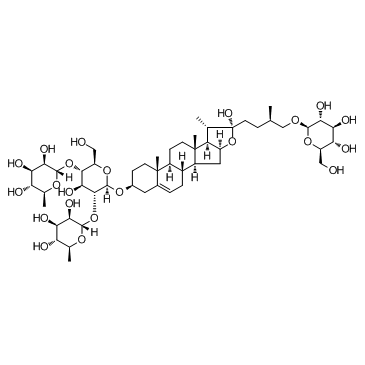| Description |
Protodioscin, a major steroidal saponin in dioscoreae rhizome, has been shown to exhibit multiple biological actions, such as anti-hyperlipidemia, anti-cancer, sexual effects and cardiovascular properties.
|
| Related Catalog |
|
| In Vivo |
Protodioscin (5 and 10 mg/kg) significantly improves glucose intolerance and reduced the levels of serum UA, BUN, Cr, TC and TG. Protodioscin significantly reduces renal concentrations of IL-1β, IL-6 and TNF-α by inhibiting the activation of nuclear factor-κB, c-Jun N-terminal kinase, p38 mitogen-activated protein kinase and extracellular signal-regulated kinase[1]. Protodioscin ameliorates the death rate, inhibits the increase in neurological deficit scores and infarct volume, and reduces the apoptotic nerve cells induced by MCAO in rats. Protodioscin attenuates the change of relevant apoptins, suppresses the release of pro-inflammatory cytokines in serum and reverses the protein expression of NF-κB (in nucleus and cytoplasm) and IκBα (in cytoplasm) induced by MCAO in rats[2]. Protodioscin (0.5 mg/kg, i.p.) increases the coagulation time by appr 50 % as compared to that of high-fat diet control rats. Protodioscin possesses a promising effect in lowering the blood levels of both lipoproteins, especially LDL, thus resulting in a high ratio of HDL/LDL[3].
|
| Animal Admin |
After habituation for 7 days, the animals are randomly divided into either the control (n=10) or experimental (n=40) group. Mice in the control group receive drinking water and standard chow, while the experimental group receive 30% (w/v) fructose in drinking water and standard chow for 12 weeks. After 6 weeks, mice receiving high-dose fructose are divided into four subgroups: fructose group (treated with CMC-Na in a matched volume), allopurinol (Allo) group (administered 5 mg/kg allopurinol hydrochloride), protodioscin-5 (Pdio-5) group (administered 5 mg/kg protodioscin) and protodioscin-10 (Pdio-10) group (administered 10 mg/kg protodioscin). Dose of protodioscin is selected according to other reports and the clinical adult dose of DR. According to the pharmacopoeia of China, the dose of DR for human is 30 g/day. Equivalently, the calculated dose of DR based on respective body surface areas for rats is 2.6 g/kg/day. The average content of protodioscin in DR is 0.183%, and so the dose of protodioscin for rats is 4.76 mg/kg/day. Therefore, the 5 mg/kg/day is as low dose, and 10 mg/kg/day is as high dose in this study. All drugs are administered orally once daily between 9:00 and 11:00 a.m., continuously for 6 weeks.
|
| References |
[1]. Shen J, et al. Protodioscin ameliorates fructose-induced renal injury via inhibition of the mitogen activated protein kinase pathway. Phytomedicine. 2016 Nov 15;23(12):1504-1510. [2]. Zhang X, et al. Potential neuroprotection of protodioscin against cerebral ischemia-reperfusion injury in rats through intervening inflammation and apoptosis. Steroids. 2016 Sep;113:52-63. [3]. Wang T, et al. Antihyperlipidemic effect of protodioscin, an active ingredient isolated from the rhizomes of Dioscorea nipponica. Planta Med. 2010 Oct;76(15):1642-6.
|


